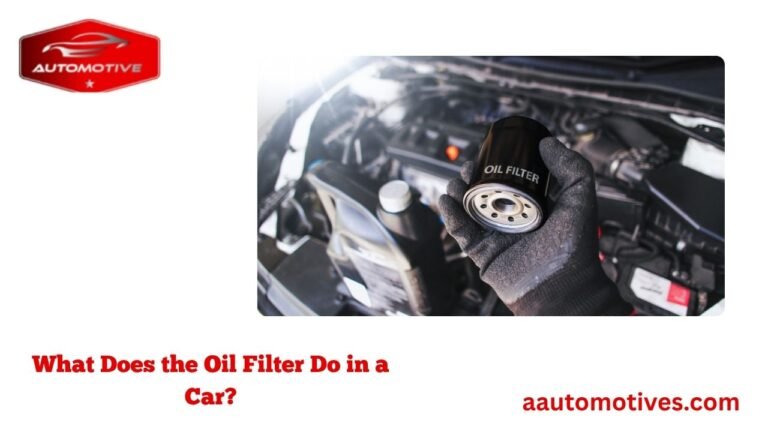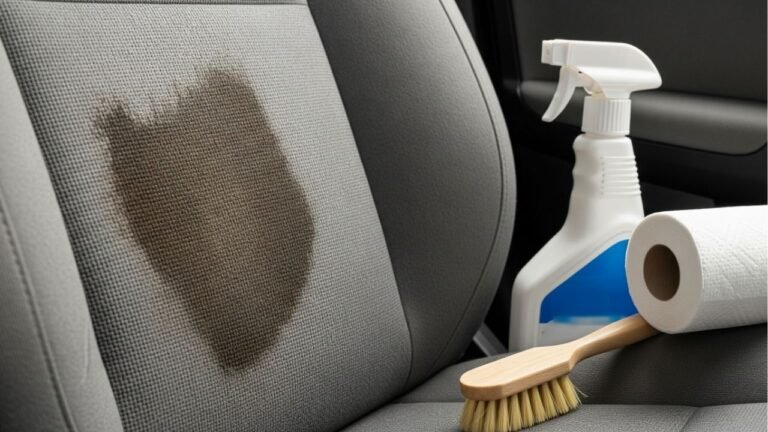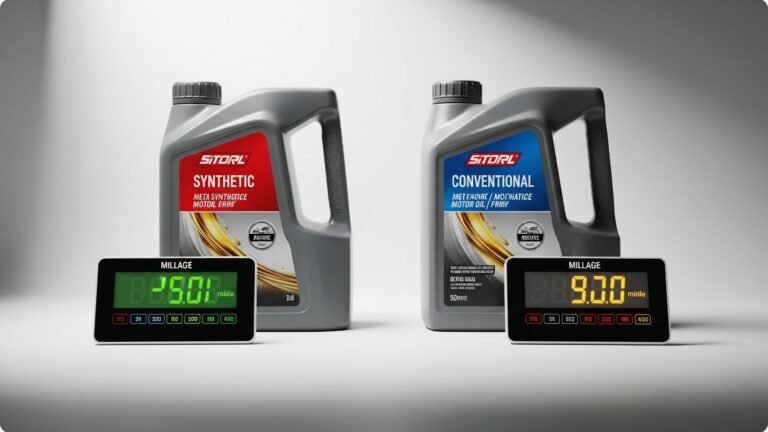Why Is My Car Oil Low?

You’re driving home from work, and suddenly the oil light blinks on. Your heart skips. You just changed the oil, right? You wonder: why is my car oil low again?
Don’t worry, you’re not alone. I’ve been there, and most car owners have too. It’s frustrating, confusing, and sometimes a bit scary. Oil is your car’s lifeblood. When it’s low, things can go wrong quickly — from overheating to engine failure.
This guide is here to help you figure it out — simply, clearly, and with real-life understanding. We’ll explore the causes, solutions, and things you can do today to fix it.
Let’s get into it.
What Does Engine Oil Actually Do?

Engine oil does four essential things:
-
Lubricates moving parts to reduce friction
-
Cools the engine by carrying away heat
-
Cleans dirt and debris using detergents in the oil
-
Protects parts from corrosion
If the oil level is low, your engine works harder. That means more heat, more wear, and a much shorter engine life.
Common Signs Your Car Oil is Low
Sometimes your oil is low before the warning light ever blinks. Look out for these signs:
-
Burning smell coming from the engine
-
Tapping or knocking sounds during acceleration
-
Oil warning light on the dashboard
-
Exhaust smoke that looks bluish
-
Poor engine performance or sluggish acceleration
If you notice any of these symptoms, check your oil dipstick immediately. It’s a 2-minute job that can save you thousands.
You’re Losing Oil Through a Leak
One of the most common reasons why your car oil is low is because it’s leaking. You might not even notice it if the leak is small. But over time, it adds up.
Imagine your engine like a bottle with a tiny hole. Even if you fill it, it won’t stay full for long.
Signs of an Oil Leak:
-
Oil stains under your parked car
-
A strong burnt oil smell
-
Visible oil around the engine gasket or valve cover
Common Leak Areas:
| Leak Location | Description |
|---|---|
| Valve Cover Gasket | Leaks at the top of the engine |
| Oil Pan Gasket | Leaks from the bottom of the engine |
| Oil Filter Housing | Weak seal or wrong filter type |
| Front/Rear Seals | Cracks near engine block joints |
If you keep topping up but oil still vanishes, check for leaks first.
Your Engine Is Burning Oil
Ever seen blue smoke from your tailpipe? That’s a telltale sign your engine is burning oil. It happens when oil sneaks past worn piston rings or valve seals and burns inside the engine.
This is not normal — especially in newer vehicles. But in older engines, especially those with 100,000+ miles, it’s sadly quite common.
Why This Happens:
-
Worn piston rings let oil enter combustion chamber
-
Valve seals break down over time
-
Excess heat accelerates wear and oil breakdown
How to Know:
-
You don’t see leaks, but oil keeps dropping
-
Your exhaust smoke is blue
-
Your spark plugs have oily deposits
Fixing this issue often requires engine work. But sometimes switching to a high-mileage oil with seal conditioners can slow the burn.
Poor Quality Oil or Wrong Oil Type
Not all oils are created equal. Using the wrong type of oil — or cheap, thin oil — can cause it to evaporate or degrade faster, especially in hot climates.
Think of it like using cheap sunscreen at the beach. You’ll get burned, and your engine will too.
Symptoms of Bad Oil:
-
Oil looks dark and watery within a few hundred miles
-
The oil level drops rapidly without leaks or smoke
-
Engine seems noisy or sluggish
Always Check:
-
The oil type (check your car manual — 5W-30? 10W-40?)
-
Brand quality — go for trusted names like Mobil 1, Castrol, or Valvoline
-
Oil viscosity — thinner oils evaporate more easily in heat
If you’re using the wrong oil, it may not protect your engine — and it’ll vanish faster than expected.
Skipping Oil Changes
We all get busy. But skipping or delaying oil changes leads to dirty, ineffective oil. Dirty oil can’t lubricate well. It breaks down and leaves sludge behind. Eventually, your oil level drops because sludge replaces usable oil.
What Happens If You Wait Too Long:
-
Oil turns into sticky goo
-
Sludge clogs your oil filter
-
Engine overheats and wears down
Follow the 5,000 to 7,000-mile rule unless your manual says otherwise. And check your oil at least once a month. Your car will thank you.
Engine Wear and Tear Over Time
Sometimes, there’s no leak, no burn, and you still wonder: “why is my car oil low?” If your car is older, it might just be worn out internally.
Engines with over 150,000 miles tend to consume more oil naturally. Even tight seals loosen over time.
How to Spot It:
-
Oil drops every 1,000–1,500 miles
-
No visible smoke or leak
-
Engine still runs well, but oil needs topping up
This isn’t the end of the world. Just monitor it regularly. Switching to high-mileage oil can also help reduce oil loss and extend engine life.
You Might Be Overfilling or Underfilling the Oil
Here’s something surprising: too much oil can be just as bad as too little. Overfilling causes pressure build-up, leading to oil foaming, seal damage, and leaks. On the other hand, if your mechanic or you underfilled the oil during a change, you’re already starting off low.
It’s kind of like overwatering or underwatering a plant — both can cause problems.
Signs of Overfilled Oil:
-
White smoke from the exhaust
-
Oil leaks shortly after an oil change
-
A strange whirring or frothy noise from the engine
Always use the dipstick to check. It has a high and low mark. Keep the level in between. Never trust just the jug measurement — always verify manually.
Driving Habits That Drain Oil Faster
Sometimes the way we drive causes oil to run out faster than normal. I learned this the hard way on a summer road trip through the hills of Chittagong — constant uphill driving, high RPMs, and heat made the oil vanish quicker than usual.
Driving like this regularly causes:
-
Higher engine temperatures
-
More wear and tear on seals and pistons
-
Faster oil oxidation and breakdown
Common Habits That Use Up Oil:
-
Hard acceleration or aggressive driving
-
Idling for long periods, especially in traffic
-
Towing heavy loads
-
Frequent short trips (oil doesn’t warm up fully)
The takeaway? Be mindful of how you drive. Smooth and steady wins the race — and saves oil.
Extreme Weather Conditions
Temperature affects engine oil more than people realize. If you live somewhere really hot (like Dhaka in April) or cold (like northern Europe), oil behaves differently.
In hot weather, oil thins out and evaporates more quickly. In freezing cold, oil thickens and flows slower — making your engine work harder.
Tips for Weather-Related Oil Loss:
-
Use oil with the right viscosity rating for your climate
-
Synthetic oils handle temperature changes better
-
Park in the shade during extreme summer heat
This one change helped me cut down oil loss during peak summer months.
What To Do If Your Car Oil Is Low
Let’s say you checked your dipstick and found the oil level below the minimum line. Don’t panic — but don’t ignore it either. Here’s what to do step-by-step:
Quick Fixes:
-
Park on level ground and let the engine cool
-
Pull out the dipstick, wipe it, reinsert, and check again
-
If low, add oil slowly, about ½ quart at a time
-
Check level again — repeat if needed
If you’re losing oil frequently, don’t just top it up — find out why. That’s like refilling a bucket with a hole in it.
When to See a Mechanic
Sometimes DIY isn’t enough. If any of these apply, get professional help:
-
You’re adding oil every few days
-
There’s visible smoke or a strong burnt smell
-
You see fresh puddles under your engine
-
The oil is milky or smells like gas
Mechanics have the tools to run pressure tests, leak detection, and engine diagnostics that go beyond what you can see at home.
Good vs Bad Oil Behavior
| Behavior | Good Oil | Bad Oil |
|---|---|---|
| Color | Golden brown | Dark, black, or milky |
| Smell | Neutral or slightly oily | Burnt, sweet, or gasoline-like |
| Level After 1000 Miles | Slight drop | Significant drop or empty |
| Appearance on Dipstick | Smooth and clean | Thick, sludgy, or watery |
| Oil Change Interval | 5,000–7,000 miles | Frequently needed or inconsistent |
Knowing what’s “normal” helps you catch what’s not.
Maintenance Tips to Prevent Low Oil Levels
Here are a few friendly reminders I wish someone had told me earlier:
-
Check oil monthly — not just at oil change time
-
Always use a funnel when adding oil (saves spills!)
-
Choose synthetic or high-mileage oil if your car is older
-
Fix small leaks fast — they turn into big problems quickly
-
Never ignore the oil warning light
FAQs About Low Car Oil
1. How often should I check my car’s oil level?
At least once a month — or before a long trip. It only takes a minute and can save you thousands in repairs.
2. Can low oil cause engine damage?
Yes. Low oil reduces lubrication, causes overheating, and can destroy your engine if ignored for too long.
3. Is it okay to just add oil instead of changing it?
Only as a temporary fix. Over time, oil gets dirty and loses effectiveness. Regular oil changes are essential.
4. Why is my oil light on even after adding oil?
Your oil pressure sensor might be faulty, or there could still be an underlying issue like a leak or pump failure.
5. Is burning oil normal?
A tiny bit in older engines, yes. But blue smoke, frequent top-offs, or oily spark plugs are warning signs.
6. What oil should I use to reduce consumption?
Try a high-mileage synthetic oil — they contain additives that swell seals and reduce leaks.
7. Can hot weather make my car lose oil faster?
Absolutely. Heat causes oil to thin and evaporate, especially if it’s not synthetic or if it’s old.
8. How do I know if my oil is leaking or burning?
If you see oil stains, it’s likely leaking. If there’s no stain but oil is disappearing, it’s probably being burned inside the engine.
Final Thoughts: Keep an Eye on the Lifeblood of Your Car
If you’ve ever asked, “why is my car oil low?”, now you know it’s not always one easy answer. It could be a small leak, the wrong oil, worn engine parts, or even how you drive.
Your car’s engine is like your heart. And oil? That’s the blood. If it’s not flowing right — if it’s too low, too dirty, or too thin — everything starts to go wrong.
So next time the dipstick shows low or the warning light blinks, don’t wait. Take it seriously. Whether you fix it yourself or go to a pro, acting early can save your engine — and your wallet.






